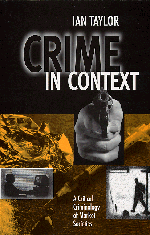

![]()
![]()

Overall I found this to be a highly thought provoking and challenging book. It is clear to me that whist Taylor endeavours to situate his own work within the left realist criminology of the UK, it feels more like a search for the underlying generative mechanisms of the aetiology of crime and crime control to be found in the left realism of the work of Elliott Currie in the United States. However, having said that this is also tantalisingly only a partial vision and analysis of such an aetiology. From one point of view all of the crises identified by Taylor can be seen primarily as crises for the male heterosexual middle classes. Such crises may be real and thereby be real in their consequences, especially for the discipline of criminology, but the question remains for whom do these crises really exist? Not for those who popularly support the increasing use of imprisonment as a response to crime for example. Not for those who are benefiting from the increasing globalisation of business and business management, for example. Not for those young people and communities long excluded from the social processes of which Taylor speaks and for whom there is no observable benefit in managing their lives differently, for example.
What we have here is a profound recognition of the tensions between the global and the local, between those included in the emergence and management of those process and those excluded from them; a profound recognition of the tensions between modernism and post-modernism. But simultaneously we also have a book that is unable to stand back from these tensions and reflect upon them and their relevance for anyone other than criminology and criminologists. A valuable contribution in and of itself (if only more of the criminological discourse were around these kinds of questions); written in a self assured and convincing style; but for me only painting part of the contemporary picture and therefore only providing us with part of the way forward. As a consequence it is a moot point as to whether this book does offer criminology a reconstituted critical agenda; what is does offer, however, is a challenging, thought provoking read with a significant insight into the current state of criminology.
Sandra Walklate
Manchester Metropolitan University